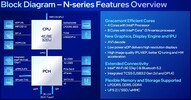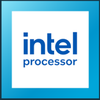Intel Core i3-N305 vs Intel Processor N150
Intel Core i3-N305
► remove from comparison
The Intel Core i3-N305 is an entry-level mobile CPU for thin and light laptops from the Alder Lake-N series. It was announced in early 2023 and offers no performance cores and 8 efficient cores (E-cores, Gracemont architecture). The chip does not support HyperThreading and clocks with up to 3.8 GHz. The performance of the E-cores should be similar to old Skylake cores (compare to the Core i7-6700HQ). All cores can use up to 6 MB L3-cache.
Performance
We have not tested a single system built around the N305, as of September 2023. Expect the chip to be 50% to 100% faster than the N95 (4 cores, 4 threads, up to 3.4 GHz).
Your mileage may vary depending on how high the CPU power limits are and how competent the cooling solutuion of your system is.
Features
The Alder Lake-N chips only support single channel memory with up to DDR5-4800, DDR4-3200 or LPDDR5-4800. The chip also supports Quick Sync and AV1 decoding (most likely same engine as in Alder Lake). Furthermore, Wi-Fi 6E and Bluetooth 5.2 are partly integrated (but no Thunderbolt). External chips can be connected via PCIe Gen3 x9 (via the PCH).
The integrated graphics adapter is based on the Xe-architecture and offersall 32 EUs (Execution Units) operating at up to 1.25 GHz. In addition to the single channel memory, the gaming performance is very limited of the iGPU.
Power consumption
The i3 has a base power consumption of 15 W and can be configured down to 9 W. The CPU is built with a further improved 10nm SuperFin process at Intel (called Intel 7).
Intel Processor N150
► remove from comparison
The Intel Processor N150 is the slowest mobile processor of the Twin Lake family. Twin Lake is mostly identical to Alder Lake-N, an architecture that will turn 4 in H2 2025. The N150 is meant for entry-level laptops, tablets and mini PCs with no fans; it offers 4 Efficient (Gracemont) cores that run at up to 3.6 GHz, but no Performance cores. Compared to the N250, the N150 has a significantly slower iGPU and slightly lower CPU clock speeds.
Gracemont E-cores do not support Hyper-Threading. No extra threads here.
Performance
Its multi-thread performance should be about as good as older dual-core CPUs like the Core i3-10110U. Exact figures depend on the cooling solution and TDP settings of the system. Either way, this is a pretty slow chip that is only just fast enough for basic tasks.
Graphics
The SoC comes equipped with a Xe-architecture graphics unit with 24 EUs (Execution Units) running at up to 1.0 GHz. The iGPU can drive up to 3 UHD 2160p monitors and hardware-decodes AV1 among other popular video codecs. Due to the low number of Xe cores and the single-channel RAM restriction, gaming performance is only good enough for very old games and low resolutions such as XGA 1024 x 768.
Architecture and Features
The integrated memory controller supports single-channel DDR4-3200, DDR5-4800 and LPDDR5-4800 RAM. PCIe NVMe SSD speeds are capped at 3.9 GB/s, corresponding to the PCIe 3 spec. There is no Thunderbolt / USB 4 support here, however, the latest Intel CNVi Wi-Fi 7 wireless networking modules are supported.
Its L3 cache is relatively small at 6 MB, and it has no proper NPU (and thus no Copilot+ branding).
Power consumption
The N150 is supposed to consume 6 watts when under longer loads. This is the Intel-recommended PL1 for the chip. No data on PL2 has been provided but values higher than 15 W are unlikely.
The SoC is manufactured using the second-generation 10 nm process marketed as Intel 7 meaning power efficiency isn't great here compared to the latest 3 nm silicon from the likes of Apple.
| Model | Intel Core i3-N305 | Intel Processor N150 | ||||||||||||||||||||||||||||||||||||||||||||
| Codename | Alder Lake-N | Twin Lake | ||||||||||||||||||||||||||||||||||||||||||||
| Series | Intel Alder Lake-N | Intel Alder Lake-N | ||||||||||||||||||||||||||||||||||||||||||||
| Series: Alder Lake-N Twin Lake |
|
| ||||||||||||||||||||||||||||||||||||||||||||
| Clock | 1800 - 3800 MHz | <=3600 MHz | ||||||||||||||||||||||||||||||||||||||||||||
| L1 Cache | 768 KB | |||||||||||||||||||||||||||||||||||||||||||||
| L2 Cache | 4 MB | |||||||||||||||||||||||||||||||||||||||||||||
| L3 Cache | 6 MB | 6 MB | ||||||||||||||||||||||||||||||||||||||||||||
| Cores / Threads | 8 / 8 8 x 3.8 GHz Intel Gracemont E-Core | 4 / 4 4 x 3.6 GHz Intel Gracemont E-Core | ||||||||||||||||||||||||||||||||||||||||||||
| TDP | 15 Watt | 6 Watt | ||||||||||||||||||||||||||||||||||||||||||||
| Technology | 10 nm | 10 nm | ||||||||||||||||||||||||||||||||||||||||||||
| max. Temp. | 105 °C | |||||||||||||||||||||||||||||||||||||||||||||
| Socket | BGA1264 | BGA1264 | ||||||||||||||||||||||||||||||||||||||||||||
| Features | DDR4-3200/DDR5-4800/LPDDR5-4800 RAM (sin. chan.), PCIe 3, GNA, MMX, SSE, SSE2, SSE3, SSSE3, SSE4.1, SSE4.2, AVX, AVX2, BMI2, ABM, FMA, ADX, VMX, SMEP, SMAP, EIST, TM1, TM2, Turbo, SST, AES-NI, RDRAND, RDSEED, SHA | DDR4-3200/DDR5-4800/LPDDR5-4800 RAM (sin. chan.), PCIe 3, GNA, MMX, SSE, SSE2, SSE3, SSSE3, SSE4.1, SSE4.2, AVX, AVX2, BMI2, ABM, FMA, ADX, VMX, SMEP, SMAP, EIST, TM1, TM2, Turbo, SST, AES-NI, RDRAND, RDSEED, SHA | ||||||||||||||||||||||||||||||||||||||||||||
| iGPU | Intel UHD Graphics 32EUs (Alder Lake) (1000 - 1250 MHz) | Intel UHD Graphics 24EUs (Alder Lake-N) ( - 1000 MHz) | ||||||||||||||||||||||||||||||||||||||||||||
| Architecture | x86 | x86 | ||||||||||||||||||||||||||||||||||||||||||||
| Announced | ||||||||||||||||||||||||||||||||||||||||||||||
| Manufacturer | ark.intel.com | www.intel.com |
Benchmarks
Average Benchmarks Intel Core i3-N305 → 100% n=52
Average Benchmarks Intel Processor N150 → 83% n=52
* Smaller numbers mean a higher performance
1 This benchmark is not used for the average calculation












